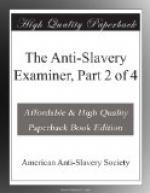When we entered the chapel the service had begun, and the people were standing, and repeating their liturgy. The house, which was capable of holding about a thousand persons, was filled. The audience were all black and colored, mostly of the deepest Ethiopian hue, and had come up thither from the estates, where once they toiled as slaves, but now as freemen, to present their thank-offerings unto Him whose truth and Spirit had made them free. In the simplicity and tidiness of their attire, in its uniformity and freedom from ornament, it resembled the dress of the Friends. The females were clad in plain white gowns, with neat turbans of cambric or muslin on their heads. The males were dressed in spencers, vests, and pantaloons, all of white. All were serious in their demeanor, and although the services continued more than two hours, they gave a wakeful attention to the end. Their responses in the litany were solemn and regular.
Great respect was paid to the aged and infirm. A poor blind man came groping his way, and was kindly conducted to a seat in an airy place. A lame man came wearily up to the door, when one within the house rose and led him to the seat he himself had just occupied. As we sat facing the congregation, we looked around upon the multitude to find the marks of those demoniac passions which are to strew carnage through our own country when its bondmen shall be made free. The countenances gathered there, bore the traces of benevolence, of humility, of meekness, of docility, and reverence; and we felt, while looking on them, that the doers of justice to a wronged people “shall surely dwell in safety and be quiet from fear of evil.”
After the service, we visited the Sabbath school. The superintendent was an interesting young colored man. We attended the recitation of a Testament class of children of both sexes from eight to twelve. They read, and answered numerous questions with great sprightliness.
In the afternoon we attended the Episcopal church, of which the Rev. Robert Holberton is rector. We here saw a specimen of the aristocracy of the island. A considerable number present were whites,—rich proprietors with their families, managers of estates, officers of government, and merchants. The greater proportion of the auditory, however, were colored people and blacks. It might be expected that distinctions of color would be found here, if any where;—however, the actual distinction, even in this the most fashionable church in Antigua, amounted only to this, that the body pews on each side of the broad aisle were occupied by the whites, the side pews by the colored people, and the broad aisle in the middle by the negroes. The gallery, on one side, was also appropriated to the colored people, and on the other to the blacks. The finery of the negroes was in sad contrast with the simplicity we had just seen at the Moravian chapel. Their dresses were of every color and style; their hats were of all shapes and sizes, and fillagreed with the most tawdry superfluity of ribbons. Beneath these gaudy bonnets were glossy ringlets, false and real, clustering in tropical luxuriance. This fantastic display was evidently a rude attempt to follow the example set them by the white aristocracy.




